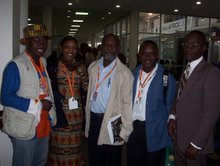POWER (ELECTRICITY) FROM GARBAGE - Kumasi takes the lead
THE construction of a plant to generate between 30 and 52 megawatts of electricity from garbage is under way in Kumasi.
President John Agyekum Kufuor performed the sod-cutting at the project site at the weekend.
The almost $136 million project is expected to generate energy from the Kumasi Metropolitan Assembly’s (KMA’s) landfill site at Oti to serve the Kumasi metropolis, depending on the volume of waste supplied to the landfill site per day. The gas from the waste materials will be used to generate energy.
The Kumasi metropolis currently generates about 1,000 tonnes of waste per day.
In November last year, the government, through the Ministry of Local Government, Rural Development and Environment, and the KMA signed a contract with the contractors, Cinergex Solutions Limited from Canada, for the construction of the plant.
Cinergex Solutions is the sole financier of the project, excluding Value Added Tax (VAT), and is expected to use 14 months to construct the plant, which is on a build-operate-and-transfer (BOT) basis.
Cinergex has consequently signed a power purchase agreement (PPA) with the Electricity Company of Ghana (ECG). The electricity produced by the waste-to-energy plant will supplement the ECG’s power supply from the Volta River Authority (VRA) for the Kumasi metropolis.
.JPG)
At the sod-cutting ceremony, President Kufuor said the government, through the Ministry of Local Government, Rural Development and Environment, would encourage other metropolitan and municipal assemblies which had the capacity and capability to explore the possibility of turning their waste into energy.
He said that was in fulfilment of the government’s desire not to rely solely on one power supply company but to open up the energy sector to others to create competition.
The energy to be generated by the plant depends greatly on the volume of waste supply to the landfill site and, according to experts, 500 tonnes of waste per day will generate 12 megawatts of electricity, 1,000 tonnes will produce between 30 and 52 megawatts of power, while 1,600 tonnes of waste per day will produce a maximum of 60 megawatts, which happens to be the maximum capacity of the plant.
President Kufuor said it would be prudent on the part of the KMA to liaise with other assemblies nearby to supplement and complement its waste requirements so that the plant could operate at full capacity.
.JPG)
He urged the KMA to strive to intensify its waste collection in order to provide enough raw materials for the plant.
“This is where your collaboration with the private sector comes on stream. Since the assembly alone cannot supply sufficient waste, the services of private companies should be sought,” the President said.
He stressed the need for people to have a positive attitude towards waste generation, saying, “Let us see waste as an economic resource. As such, let us stop littering the environment and rather separate waste into manageable components.”
President Kufuor said apart from helping the Kumasi metropolis with its sanitary challenges, the project would also provide jobs for young engineers and administrators and could again serve as an industrial training centre for Electrical Engineering students of the Kwame Nkrumah University of Science and Technology (KNUST), thereby serving as a source of transferring knowledge and skills to Ghanaians.
He said the current energy situation had affected every aspect of the economy, especially the manufacturing sector, adding that government would embrace projects such as the waste-to-energy programme to add to the energy requirement.
President Kufuor said the government would continue to pursue its policy of creating a congenial economic environment for both foreign direct investment and local entrepreneurship to flourish.
.JPG)
The Minister of Local Government, Rural Development and Environment, Mr Stephen Asamoah-Boateng, said the issue of waste collection and sanitation in general had been a major challenge for local authorities and that it was good news that energy could now be generated from waste in Ghana.
The KMA Chief Executive, Madam Patricia Appiagyei, said Kumasi had one of the best landfill sites in the West African sub-region and that it was good news that the site was going to be used to generate electricity.
She said the KMA would soon launch the city-wide waste collection levy.









































1 comment:
It is my understanding that Cinergex is employing a common methane gas (bio-gas) extraction process technology. This essentially involves the gathering of methane gas from within a landfill using a series of underground pipes and then combusting the gas in an internal combustion engine (GEJennbacher, Caterpillar or Cummins) attached to a generator.
Since landfills produce large quantities of methane gas anyway (a result of the decomposition of the organic waste materials deposited into the landfill) this technology is becoming very popular around the world to reduce greenhouse gases. (Methane is the worst offender.) The fact that the process produces electricity in much the same way as a diesel generator, it does represent a practical way to produce power, but like any other power project the PPA price must be sufficiently high enough to justify the capital costs.
The biggest problem with bio-gas projects is the fact that the landfill problems still exist even though methane extraction somewhat reduces their impact. For instance, the landfill still emits greenhouse gases and still leaches out harmful pollutants into the ground water. Plastics and other materials, which are otherwise combustible in our WTE process, will remain buried in the ground for hundreds of years and the offensive odors continue to linger. The size of the landfill and the need for more landfill space will continue to grow whereas our process reduces the need for landfill space. Assuming we can utilize the ash for concrete products, we may be able eliminate the need for landfills altogether.
Post a Comment